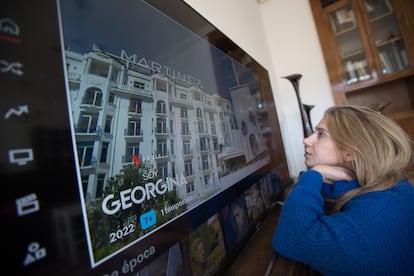Itching, pain, blurry vision: How big TVs affect our eyes and neck
Experts recommend placing a screen at a distance where it is within view without having to move your head. But as homes get smaller and television sets get larger, this can be a challenge

First-row seats at the movie theater are typically the last ones to sell. The experience, especially in the older theaters, is not very pleasant – you need to crane your neck to see the screen, and because you’re too close to it, you can’t even see the whole picture.
Now that all the main television manufacturers are selling us the possibility of turning our living rooms into a screening room, there is a risk that we might end up in the same uncomfortable “front-row” position if we fail to consider how far from the TV set we are going to sit.
The numbers are moving in opposite directions. On one hand, TV sets are getting bigger. “Sales trends are favoring ever-larger sizes, with a focus on 65 inches and above,” says Ignacio Herrero Alegret, product manager of Brown Goods at MediaMarkt Iberia.
On the other hand, there is a trend towards ever smaller homes. In Spain, for instance, the average size of new housing has been shrinking for years, according to the Public Works Ministry. In a country where 66% of the population lives in apartments, the average size dropped from 118.7 square meters (1,277 square feet) in 2017 to 108.1 square meters (1,163 square feet) in 2021.
Some manufacturers recommend for the screen to take up 40 degrees of the viewer’s field of vision, explains Daniel Pamiés, head of product at Samsung Electronics. In order to calculate the right distance, “you need to multiply the TV’s inches by 3.04 in order to obtain the distance in centimeters. If it’s a 55-inch TV, that is 1.7 meters [5.5 feet], for a 65-inch TV the right distance is two meters [6.5 feet].”
The optometrist Carmen Bilbao explains that when our heads are still, our eyes move quickly and comfortably, but if the image we are looking at takes up more than 30 degrees of width in our field of vision, it will make us move our heads.
“If you buy a really large TV and look at it from a short distance, you will have to move your head more to see the whole image,” she notes. The eyes’ saccadic movements – rapid shifts of gaze – will be more intense and more uncomfortable.
This could also lead to neck and back problems, adds the optician and optometrist Adriana Tempranos. “Those repetitive movements and anomalous sitting positions could create discomfort later requiring help from specialists in ophthalmology or traumatology,” she says. Tempranos recommends a distance of between 3.5 and 4.5 meters (11 to 15 feet) to watch a 75-inch TV.
Experts also note that watching a lot of TV can cause other types of discomfort such as dry or itchy eyes, and blurry vision.
Tu suscripción se está usando en otro dispositivo
¿Quieres añadir otro usuario a tu suscripción?
Si continúas leyendo en este dispositivo, no se podrá leer en el otro.
FlechaTu suscripción se está usando en otro dispositivo y solo puedes acceder a EL PAÍS desde un dispositivo a la vez.
Si quieres compartir tu cuenta, cambia tu suscripción a la modalidad Premium, así podrás añadir otro usuario. Cada uno accederá con su propia cuenta de email, lo que os permitirá personalizar vuestra experiencia en EL PAÍS.
¿Tienes una suscripción de empresa? Accede aquí para contratar más cuentas.
En el caso de no saber quién está usando tu cuenta, te recomendamos cambiar tu contraseña aquí.
Si decides continuar compartiendo tu cuenta, este mensaje se mostrará en tu dispositivo y en el de la otra persona que está usando tu cuenta de forma indefinida, afectando a tu experiencia de lectura. Puedes consultar aquí los términos y condiciones de la suscripción digital.










































